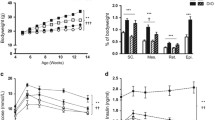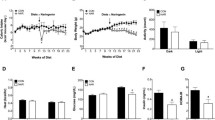Abstract
Purpose
Obesity increases the risk of diabetes. The dysregulation of estrogen metabolism has been associated with the susceptibility to obesity and diabetes. Here, we explore the role estrogen plays in sex differences in obesity and glucose metabolism, specifically adipocyte biology.
Methods
We randomized C57BL/6 J male, non-ovariectomized female, ovariectomized female, and ovariectomized female mice supplemented with 17β estradiol to receive a calorie-restricted, low- or a high-fat diet (15 mice per group). We measured weight gained, calories consumed, percent body fat, abdominal adipose tissue, adipocyte size, lipogenic and adipogenic gene expression, and glucose tolerance.
Results
Male mice had a higher susceptibility to obesity than intact female mice. However, removal of the ovaries in female mice eliminated the protection to obesity and estrogen supplementation restored this protection. Male and ovariectomized female mice gained weight predominately in the form of abdominal adipose tissue possibly due to an increase in adipocyte size. Moreover, for mice consuming the high-fat diet, male and ovariectomized female mice had significantly higher levels of leptin mRNA and lower hormone-sensitive lipase mRNA relative to intact female mice and ovariectomized female mice supplemented with estrogen. Additionally, estrogen had a strong inhibitory effect on key adipogenic genes in non-ovariectomized female and ovx-female mice supplemented with estrogen. Finally, we show that male and ovariectomized female mice consuming the high-fat diet had a higher incidence of glucose intolerance.
Conclusion
Estrogen protects female mice from obesity and impaired glucose tolerance possibly by modulating the expression of genes regulating adipogenesis, lipogenesis, and lipolysis.







Similar content being viewed by others
References
Flegal K, Carroll M, Ogden C, Johnson C (2002) Prevalence and trends in obesity among US adults, 1999–2000. JAMA 288:1723–1727
Hong J, Stubbins R, Smith R, Harvey A, Núñez N (2009) Differential susceptibility to obesity between male, female and ovariectomized female mice. Nutr J 8:11–16
Cooke PS, Naaz A (2004) Role of estrogens in adipocyte development and function. Exp Biol Med (Maywood) 229:1127–1135
Wade GN, Gray JM, Bartness TJ (1985) Gonadal influences on adiposity. Int J Obes 9 Suppl 1:83–92
Meli R, Pacilio M, Raso GM, Esposito E, Coppola A, Nasti A, Di Carlo C, Nappi C, Di Carlo R (2004) Estrogen and raloxifene modulate leptin and its receptor in hypothalamus and adipose tissue from ovariectomized rats. Endocrinology 145:3115–3121
Jones M, Thorburn A, Britt K, Hewitt K, Wreford N, Proietto J, Oz O, Leury B, Robertson K, Yao S, Simpson E (2000) Aromatase-deficient (ArKO) mice have a phenotype of increased adiposity. Proc Natl Acad Sci USA 97:12735–12740
Hao L, Wang Y, Duan Y, Bu S (2010) Effects of treadmill exercise training on liver fat accumulation and estrogen receptor alpha expression in intact and ovariectomized rats with or without estrogen replacement treatment. Eur J Appl Physiol 109:879–886
Heine P, Taylor J, Iwamoto G, Lubahn D, Cooke P (2000) Increased adipose tissue in male and female estrogen receptor-alpha knockout mice. Proc Natl Acad Sci USA 97:12729–12734
Brown LM, Clegg DJ (2010) Central effects of estradiol in the regulation of food intake, body weight, and adiposity. J Steroid Biochem Mol Biol 122:65–73
Eckel LA (2011) The ovarian hormone estradiol plays a crucial role in the control of food intake in females. Physiol Behav 104:517–524
Musatov S, Chen W, Pfaff D, Mobbs C, Yang X, Clegg D, Kaplitt M, Ogawa S (2007) Silencing of estrogen receptor alpha in the ventromedial nucleus of hypothalamus leads to metabolic syndrome. Proc Natl Acad Sci USA 104:2501–2506
Homma H, Kurachi H, Nishio Y, Takeda T, Yamamoto T, Adachi K, Morishige K, Ohmichi M, Matsuzawa Y, Murata Y (2000) Estrogen suppresses transcription of lipoprotein lipase gene. Existence of a unique estrogen response element on the lipoprotein lipase promoter. J Biol Chem 275:11404–11411
D’Eon T, Souza S, Aronovitz M, Obin M, Fried S, Greenberg A (2005) Estrogen regulation of adiposity and fuel partitioning. Evidence of genomic and non-genomic regulation of lipogenic and oxidative pathways. J Biol Chem 280:35983–35991
Wu Z, Xie Y, Bucher NL, Farmer SR (1995) Conditional ectopic expression of C/EBP beta in NIH-3T3 cells induces PPAR gamma and stimulates adipogenesis. Genes Dev 9:2350–2363
Phan J, Peterfy M, Reue K (2005) Biphasic expression of lipin suggests dual roles in adipocyte development. Drug News Perspect 18:5–11
Tontonoz P, Hu E, Spiegelman BM (1994) Stimulation of adipogenesis in fibroblasts by PPAR gamma 2, a lipid-activated transcription factor. Cell 79:1147–1156
Yakar S, Nunez N, Pennisi P, Brodt P, Sun H, Fallavollita L, Zhao H, Scavo L, Novosyadlyy R, Kurshan N, Stannard B, East-Palmer J, Smith N, Perkins S, Fuchs-Young R, Barrett J, Hursting S, LeRoith D (2006) Increased tumor growth in mice with diet-induced obesity: impact of ovarian hormones. Endocrinology 147:5826–5834
Giovannucci E, Ascherio A, Rimm E, Colditz G, Stampfer M, Willett W (1995) Physical activity, obesity, and risk for colon cancer and adenoma in men. Ann Intern Med 122:327–334
Macotela Y, Boucher J, Tran TT, Kahn CR (2009) Sex and depot differences in adipocyte insulin sensitivity and glucose metabolism. Diabetes 58:803–812
Núñez N, Carpenter C, Perkins S, Berrigan D, Jaque S, Ingles S, Bernstein L, Forman M, Barrett J, Hursting S (2007) Extreme obesity reduces bone mineral density: complementary evidence from mice and women. Obesity (Silver Spring) 15:1980–1987
Karas RH, Schulten H, Pare G, Aronovitz MJ, Ohlsson C, Gustafsson JA, Mendelsohn ME (2001) Effects of estrogen on the vascular injury response in estrogen receptor alpha, beta (double) knockout mice. Circ Res 89:534–539
Jo J, Gavrilova O, Pack S, Jou W, Mullen S, Sumner A, Cushman S, Periwal V (2009) Hypertrophy and/or Hyperplasia: Dynamics of Adipose Tissue Growth. PLoS Comput Biol 5:e1000324
Hinz S, Rais-Bahrami S, Kempkensteffen C, Weiske W, Miller K, Magheli A (2010) Effect of obesity on sex hormone levels, antisperm antibodies, and fertility after vasectomy reversal. Urology 76:851–856
Oh J, Barrett-Connor E, Wedick N, Wingard D, Study RB (2002) Endogenous sex hormones and the development of type 2 diabetes in older men and women: the Rancho Bernardo study. Diabetes Care 25:55–60
de Ferranti S, Mozaffarian D (2008) The perfect storm: obesity, adipocyte dysfunction, and metabolic consequences. Clin Chem 54:945–955
Imbeault P, Lemieux S, Prud’homme D, Tremblay A, Nadeau A, Després J, Mauriège P (1999) Relationship of visceral adipose tissue to metabolic risk factors for coronary heart disease: is there a contribution of subcutaneous fat cell hypertrophy? Metabolism 48:355–362
Roberts R, Hodson L, Dennis A, Neville M, Humphreys S, Harnden K, Micklem K, Frayn K (2009) Markers of de novo lipogenesis in adipose tissue: associations with small adipocytes and insulin sensitivity in humans. Diabetologia 52:882–890
Fenton J, Nuñez N, Yakar S, Perkins S, Hord N, Hursting SD (2009) Diet-induced adiposity alters the serum profile of inflammation in C57BL/6 N mice as measured by antibody array. Diabetes Obes Metab 11:343–354
Frederich R, Hamann A, Anderson S, Löllmann B, Lowell B, Flier J (1995) Leptin levels reflect body lipid content in mice: evidence for diet-induced resistance to leptin action. Nat Med 1:1311–1314
Dandona P, Mohanty P, Ghanim H, Aljada A, Browne R, Hamouda W, Prabhala A, Afzal A, Garg R (2001) The suppressive effect of dietary restriction and weight loss in the obese on the generation of reactive oxygen species by leukocytes, lipid peroxidation, and protein carbonylation. J Clin Endocrinol Metab 86:355–362
Lundholm L, Zang H, Hirschberg A, Gustafsson J, Arner P, Dahlman-Wright K (2008) Key lipogenic gene expression can be decreased by estrogen in human adipose tissue. Fertil Steril 90:44–48
Hewitt K, Pratis K, Jones M, Simpson E (2004) Estrogen replacement reverses the hepatic steatosis phenotype in the male aromatase knockout mouse. Endocrinology 145:1842–1848
Abraham S, Hillyard L, Hansen F, Lin C (1980) Tissue specificity for the effect of estrogen on lipogenic activity in male and female rats. Biochim Biophys Acta 620:167–171
Hu E, Tontonoz P, Spiegelman BM (1995) Transdifferentiation of myoblasts by the adipogenic transcription factors PPAR gamma and C/EBP alpha. Proc Natl Acad Sci USA 92:9856–9860
Koh YK, Lee MY, Kim JW, Kim M, Moon JS, Lee YJ, Ahn YH, Kim KS (2008) Lipin1 is a key factor for the maturation and maintenance of adipocytes in the regulatory network with CCAAT/enhancer-binding protein alpha and peroxisome proliferator-activated receptor gamma 2. J Biol Chem 283:34896–34906
Yepuru M, Eswaraka J, Kearbey J, Barrett C, Raghow S, Veverka K, Miller D, Dalton J, Narayanan R (2010) Estrogen receptor-{beta} selective ligands alleviate high-fat diet- and ovariectomy-induced obesity in mice. J Biol Chem 285:31292–31303
Campbell SE, Mehan KA, Tunstall RJ, Febbraio MA, Cameron-Smith D (2003) 17beta-estradiol upregulates the expression of peroxisome proliferator-activated receptor alpha and lipid oxidative genes in skeletal muscle. J Mol Endocrinol 31:37–45
Campbell S, Febbraio M (2001) Effect of ovarian hormones on mitochondrial enzyme activity in the fat oxidation pathway of skeletal muscle. Am J Physiol Endocrinol Metab 281:E803–E808
Morise A, Thomas C, Landrier J, Besnard P, Hermier D (2009) Hepatic lipid metabolism response to dietary fatty acids is differently modulated by PPARalpha in male and female mice. Eur J Nutr 48:465–473
Acknowledgments
This work was supported by American Cancer Society grant ACS RSG CNE-113703 and by grants from the National Institutes of Health: National Cancer Society grant NCI 1K22CA127519-01A1 and National Institute of Environmental Health Sciences Center grants ES09145 and ES007784.
Conflict of interest
The authors have nothing to disclose.
Author information
Authors and Affiliations
Corresponding author
Rights and permissions
About this article
Cite this article
Stubbins, R.E., Holcomb, V.B., Hong, J. et al. Estrogen modulates abdominal adiposity and protects female mice from obesity and impaired glucose tolerance. Eur J Nutr 51, 861–870 (2012). https://doi.org/10.1007/s00394-011-0266-4
Received:
Accepted:
Published:
Issue Date:
DOI: https://doi.org/10.1007/s00394-011-0266-4




